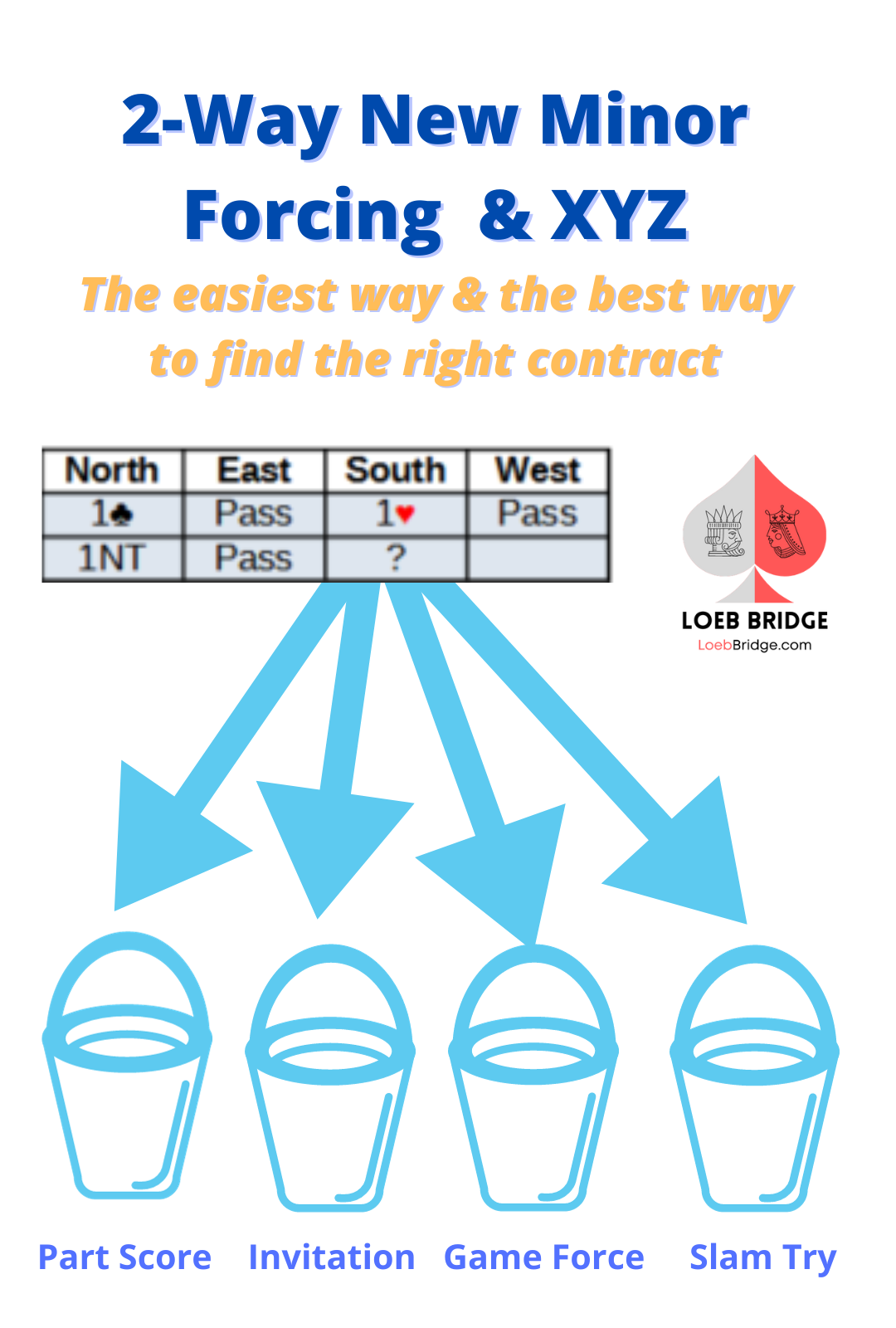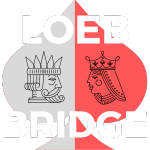After opener bids a suit and then rebids 1NT, responder is the captain of the auction and must guide their partnership to the right contract. Responder's goals may include: playing in the right strain, playing a part score contract, inviting game, forcing to game, or looking for a slam. Since there are billions of bridge hand and there are only 9 bids available between 1NT and 3NT, responder needs tools to clarify their intentions and ask opener the right questions. See below for a summary of 2-Way New Minor Forcing. If you are interested in a video lesson on 2-Way New Minor Forcing & XYZ, click on the image below and to the right.
Summary of 2-Way New Minor Forcing
In the auction below, North's 1NT bid limits their hand, showing a balanced hand with 2-3 spades.
| North | East | South | West |
| 1♦ | Pass | 1♠ | Pass |
| 1NT | ? |
How many points North is showing depends on North-South's range for a 1NT opening bid. If North-South play a strong notrump (e.g. 15-17 HCP), North's 1NT rebid shows 12-15 HCP. If North-South play a weak notrump (e.g. 12-14), North's 1NT rebid shows 15-17 HCP. Either way, North has limited their hand; and South is the Captain of the Auction. Depending on South's strength, South might wat to play in a partscore contract, invite game, force to game, or look for a slam. There isn't enough room below 3NT for natural bidding to address all of these goals. So some artificial bids are needed for responder to captain the auction to the right contract.
Some partnerships play New Minor Forcing. Some play Checkback Stayman. The main problem with these approaches is that responder uses the same artificial bid to invite game, force to game, and look for a slam. This forces opener to jump to show a hand which would accept a game try. These jumps consume bidding space needed to look for a slam or offer a choice of games.
2-Way New Minor Forcing is easier and better.
- Easier because responder has tools to communicate their goal for the auction:
- Look for the right partscore
- Invite game
- Force to game
- Look for a slam
- Better because:
- Opener doesn't need to jump to show extra values. This leaves room to look for slam or offer a choice of games.
- Responder doesn't need to jump to the 3-level to invite game with a 6-card major. Responder can invite game at the 2-level.
2-Way New Minor Forcing applies when opener bids 1-of-a-suit, responder bids 1-of-a-suit, and opener rebids 1NT. It is off after an overcall, but on after a takeout double.
Here is a summary of responder's actions playing 2-Way New Minor Forcing.
| Responder's Rebid | Explanation |
| 2♣ | Artificial, forces opener to rebid 2♦. Responder can pass to play 2♦. Any other bid is natural and invitational. |
| 2♦ | Artificial game force. Bidding continues naturally. |
| 2♥ | A natural signoff if respoder initially bid 1♥. If responder initially bid 1♠, 2♥ offers a choice between playing 2♥ and playing 2♠ |
| 2♠ | A natural signoff if responder initially bid 1♠. A natural invitation if responder initially bid 1♥ |
| 2NT | Artificial, forces opener to rebid 3♣. Responder passes to play 3♣ |
| Jump in a Suit | A natural slam try |
| 3NT | To play |
 David Loeb offers a video lesson series on 2-Way New Minor Forcing and XYZ. See below for a summary of the lesson series. Click on the image to the right to see the free trailer to the video lesson series.
David Loeb offers a video lesson series on 2-Way New Minor Forcing and XYZ. See below for a summary of the lesson series. Click on the image to the right to see the free trailer to the video lesson series.
- Introduction to 2-Way New Minor Forcing
- Responder’s Goals after opener’s 1NT rebid
- Methods to find the right contract
- Why 2-Way New Minor Forcing is easier & better
- How to use 2-Way New Minor Forcing
- 2-Way New Minor Forcing Explanations & Examples
- XYZ: using 2-Way New Minor Forcing after 3 suits are bid at the 1-level
- What to do when no rebid fits your hand
- Optional advanced agreements:
- Offer a choice between 3NT and 4 of your major without revealing opener’s distribution
- Look for a slam with support for opener’s minor and shortness





